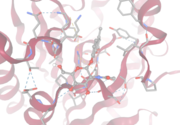Sandbox2QRU
From Proteopedia
(Difference between revisions)
| Line 28: | Line 28: | ||
'''SwissDock''' | '''SwissDock''' | ||
| - | SwissDock was used to investigate the active site binding of different substrates. The analysis of 2QRU on this site was performed with orientation parameters of 8x20x10 in a 25x25x25 Å box. The best overall interaction tested was with 4-Methylumbelliferyl 2-acetamido-2-deoxy-beta-D-glucopyranoside that showed an affinity -6.883 kcal/mol. Other significant binding affinities include 4-Nitrophenyl acetate at -5.093 kcal/mol and 4-Nitrophenyl acetate at -5.193 kcal/mol. The greatest binding affinities found were with carbohydrate-based substrates. | + | SwissDock was used to investigate the active site binding of different substrates. [[Image:4-Methylumbelliferyl 2-acetamido-2-deoxy-beta-D-glucopyranoside.png | thumb]]The analysis of 2QRU on this site was performed with orientation parameters of 8x20x10 in a 25x25x25 Å box. The best overall interaction tested was with 4-Methylumbelliferyl 2-acetamido-2-deoxy-beta-D-glucopyranoside that showed an affinity -6.883 kcal/mol. Other significant binding affinities include 4-Nitrophenyl acetate at -5.093 kcal/mol and 4-Nitrophenyl acetate at -5.193 kcal/mol. The greatest binding affinities found were with carbohydrate-based substrates. |
| Line 34: | Line 34: | ||
Based on the sequence and structural analysis via computational modeling, it is known that the primary function of 2QRU is an alpha/beta hydrolase. Using the Swiss dock, we know the substrates with the highest bonding affinity were sugar-like molecules. This produces bond affinities of -6 or lower. Knowing this, it is hypothesized that 2QRU would be used in biological systems that need to break down sugars for energy, like fermentation or cellular respiration. Where exactly this would occur or on which sugar is unknown at this time, but experimental results may aid in finding what substrate works the best and in what environment. | Based on the sequence and structural analysis via computational modeling, it is known that the primary function of 2QRU is an alpha/beta hydrolase. Using the Swiss dock, we know the substrates with the highest bonding affinity were sugar-like molecules. This produces bond affinities of -6 or lower. Knowing this, it is hypothesized that 2QRU would be used in biological systems that need to break down sugars for energy, like fermentation or cellular respiration. Where exactly this would occur or on which sugar is unknown at this time, but experimental results may aid in finding what substrate works the best and in what environment. | ||
| - | + | ||
== Relevance == | == Relevance == | ||
Revision as of 13:17, 28 April 2025
Overview
| |||||||||||
References
- ↑ doi: https://dx.doi.org/10.2210/pdb2QRU/pdb
- ↑ Herraez A. Biomolecules in the computer: Jmol to the rescue. Biochem Mol Biol Educ. 2006 Jul;34(4):255-61. doi: 10.1002/bmb.2006.494034042644. PMID:21638687 doi:10.1002/bmb.2006.494034042644

